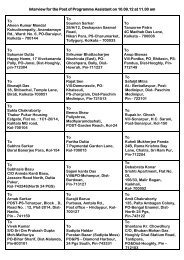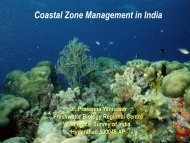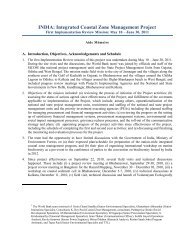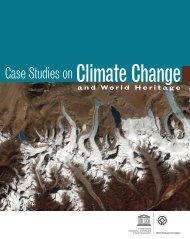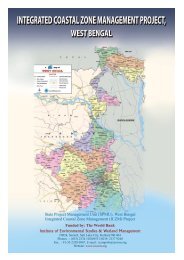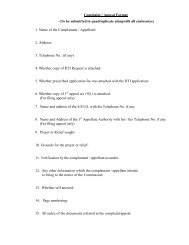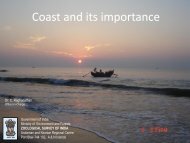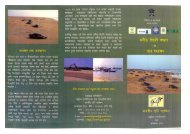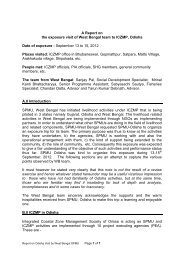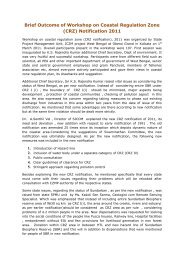Cyclone and Storm Surge - Iczmpwb.org
Cyclone and Storm Surge - Iczmpwb.org
Cyclone and Storm Surge - Iczmpwb.org
Create successful ePaper yourself
Turn your PDF publications into a flip-book with our unique Google optimized e-Paper software.
4.23<br />
At the open-sea boundary, the normal currents across the boundary may be prescribed, yielding a<br />
condition such as (25) modified by a non-zero term on the right h<strong>and</strong> side of the equation. Alternatively,<br />
a radiation type of condition may be applied, which leads to (Heaps, 1973)<br />
⎛ g<br />
u cosα<br />
+ v sinα<br />
+ ⎜<br />
⎝ h<br />
⎟<br />
⎠<br />
⎞<br />
1<br />
2<br />
ζ = 0<br />
(26)<br />
Application of a radiation type of condition (26) at the open sea boundary of a model allows the<br />
propagation of energy (disturbances) only outwards from the interior in the form of simple progressive<br />
waves. It also helps to eliminate the transient response more quickly as a result of the frictional<br />
dissipation in the system. Concerning its effectiveness Flather (1976a) notes that application of a<br />
radiation condition in the numerical model may remove the unrealistically large currents <strong>and</strong> grid scale<br />
oscillations in the vicinity of the open boundary which may possibly be produced by the application of<br />
conventional open-sea boundary condition (i.e., ζ= 0 at y=0).<br />
As usual it is assumed that the motion in the sea is generated from an initial state of rest, so that<br />
ζ = u= v= 0 everywhere for t = 0. (27)<br />
4.8.1. Determination of forcing functions<br />
The forcing terms in the prediction equations (22)-(24) are the Coriolis force, the surface pressure, wind<br />
stress components <strong>and</strong> the seabed friction. The surge is generated by an idealized cyclone, of constant<br />
strength, tracking across the analysis area with constant speed. In view of the strong associated winds<br />
<strong>and</strong> consequently high values of the wind stress forcing, the forcing due to barometric changes (i.e.)<br />
∂ p<br />
∂x<br />
a<br />
<strong>and</strong><br />
∂ p<br />
∂y<br />
a<br />
may be neglected in the surge prediction models. Further, the Coriolis force can be determined by<br />
knowing the latitudinal position of the area <strong>and</strong> the bottom stress may be parameterized in terms of<br />
depth averaged currents by a quadratic law. The problem thus remains to compute the surface winds<br />
<strong>and</strong> the wind stresses.<br />
So far no good theory exists on which a computation of the surface winds can be based. A number of<br />
numerical models use the model storms in which the wind speed is related to the pressure gradient. The<br />
pressure field is specified by:






